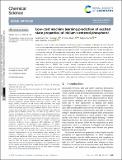Low-cost machine learning prediction of excited state properties of iridium-centered phosphors
Author(s)
Terrones, Gianmarco G; Duan, Chenru; Nandy, Aditya; Kulik, Heather J
DownloadPublished version (1.017Mb)
Publisher with Creative Commons License
Publisher with Creative Commons License
Creative Commons Attribution
Terms of use
Metadata
Show full item recordAbstract
Prediction of the excited state properties of photoactive iridium complexes challenges ab initio methods such as time-dependent density functional theory (TDDFT) both from the perspective of accuracy and of computational cost, complicating high-throughput virtual screening (HTVS). We instead leverage low-cost machine learning (ML) models and experimental data for 1380 iridium complexes to perform these prediction tasks. We find the best-performing and most transferable models to be those trained on electronic structure features from low-cost density functional tight binding calculations. Using artificial neural network (ANN) models, we predict the mean emission energy of phosphorescence, the excited state lifetime, and the emission spectral integral for iridium complexes with accuracy competitive with or superseding that of TDDFT. We conduct feature importance analysis to determine that high cyclometalating ligand ionization potential correlates to high mean emission energy, while high ancillary ligand ionization potential correlates to low lifetime and low spectral integral. As a demonstration of how our ML models can be used for HTVS and the acceleration of chemical discovery, we curate a set of novel hypothetical iridium complexes and use uncertainty-controlled predictions to identify promising ligands for the design of new phosphors while retaining confidence in the quality of the ANN predictions.
Date issued
2023Department
Massachusetts Institute of Technology. Department of Chemistry; Massachusetts Institute of Technology. Department of Chemical EngineeringJournal
Chemical Science
Publisher
Royal Society of Chemistry
Citation
Chem. Sci., 2023,14, 1419-1433
Version: Final published version